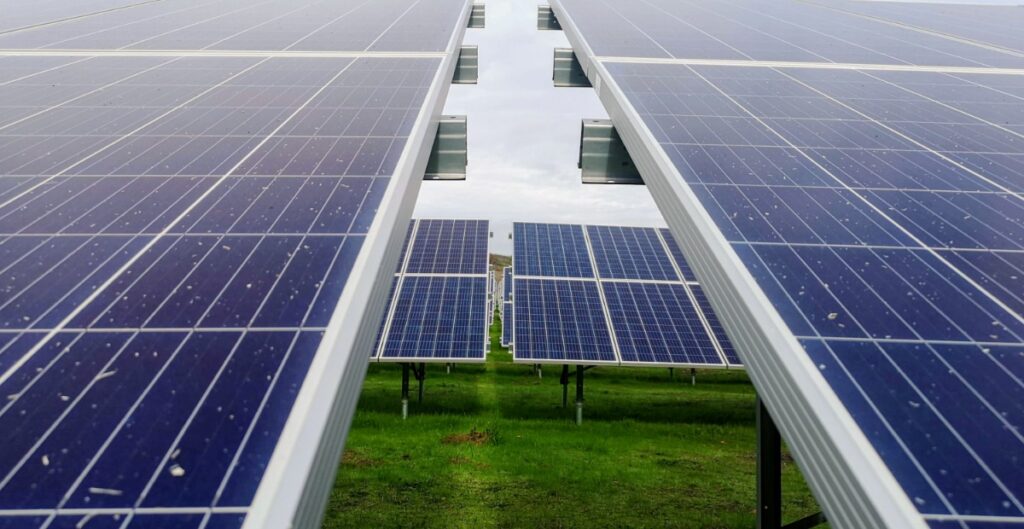Solar power is a significant component of the global clean energy mix, and the concept of floating solar panels has taken it to the next level. This innovative renewable energy technology combines solar power and water bodies, resulting in floating photovoltaic (FPV) systems or floating solar farms. By utilising the space in reservoirs and other bodies of water, we can optimise the generation of electricity without taking up valuable land space.
Floating Solar Panels
Floating solar power involves installing solar panels on a floating platform in a body of water, typically a reservoir or dam. The panels are securely anchored to the bottom of the water body to maintain stability, and the entire setup is interconnected with cables for efficient energy transmission.
In the UK, where land availability can sometimes be a limitation, floating solar panels are an excellent solution to increase solar energy production. This innovative approach provides the opportunity to generate extra electricity to power homes and industries, without negatively impacting land that could be used for recreation or agriculture.
The cooling effect of the water can increase the efficiency of the PV panels, and the panels themselves reduce evaporation from water reservoirs, which is beneficial in conserving water, particularly in drought-prone areas.
One prime example of the largest floating solar farm is in Singapore, showcasing the massive potential of this technology. In the UK, this approach could play a significant role in reaching renewable energy targets, maximising the use of available water bodies.
Floating Solar Panels and the Environment
Not only are floating solar panels a boon for energy production, but they also have significant environmental benefits. They help reduce water evaporation from reservoirs, a crucial advantage in water-scarce areas. These panels can also deter the growth of harmful algae, thereby improving water quality. Moreover, the shade they provide can lower water temperatures, which is beneficial for aquatic life.
There is a minor concern regarding potential corrosion and other maintenance issues plaguing conventional solar energy installations due to the constant water exposure. However, the floating systems are designed and constructed to mitigate these issues, ensuring a robust and long-lasting operation.
Installation of Floating Solar Panels
The process of installing a floating solar panel involves setting up a floating structure or platform, securing the PV modules on water, and connecting the entire system using suitable cables and mooring and anchoring systems. The installation is carried out in a way that doesn’t disrupt the natural balance of the water body or the reservoir.
It’s also important to note that the operation and maintenance of these solar installations require a slightly different approach compared to land-based solar farms. Given their location, these systems may require boats for access, and special considerations may need to be taken into account for safety and efficiency.
Innovating Floating Solar Panels with New Plastics
As floating solar farms become more prevalent, innovative solutions are emerging to overcome some of the challenges they face. A notable instance is the collaboration between BASF, a leading chemical company, and Noria Energy, an energy firm, in a venture to use renewable energy to improve water quality while also innovating in the design of floating solar systems.
BASF has taken the lead in installing a groundbreaking proof-of-concept floating solar system at its manufacturing site in McIntosh, Alabama. This unique system, developed by Noria Energy, uses renewable solar power to operate three aerators, which are designed to enhance the water quality of a picturesque pond located at the production facility.
However, it’s worth mentioning that the additional design and construction variables associated with floating solar systems typically come with a higher capital cost. This fact has been one of the significant hurdles that have hindered the widespread adoption of this technology.
In an effort to address these challenges, BASF’s plastic additives business has teamed up with Noria Energy to develop a highly reliable, innovative pontoon design for floating solar panels, all while keeping costs down. This collaboration aims to leverage BASF’s extensive portfolio of light stabilisers, which includes UV absorbers and Hindered Amine Light Stabilisers (HALS).
These light stabilisers are crucial in protecting the polymer materials used in the construction of the pontoons against degradation caused by harmful UV light. By enhancing the durability and longevity of these components, the floating solar panels can provide reliable clean energy production for an extended period, maximising the return on investment.
The implementation of this innovative design will not only improve the cost-effectiveness of floating solar installations but also increase their lifespan, thus making them an even more attractive option for renewable energy production. This marks an exciting step forward in the evolution of floating solar technology, showcasing how companies like BASF and Noria Energy are paving the way for future advancements in this field.
Frequently Asked Questions about Floating Solar Panels
Are floating solar panels as efficient as land-based panels?
Floating solar panels could potentially outperform land-based installations due to the cooling effect of the water, which can enhance PV efficiency. According to a study from 2021, the cooler environment helps to keep the panels at an optimal operating temperature, thereby increasing electricity generation.
Can floating solar panels be installed on any body of water?
While theoretically, floating solar panels can be installed on any water body, they are most commonly installed on freshwater bodies such as drinking water reservoirs or hydroelectric dam reservoirs.
What is the disadvantage of floating solar panels?
While floating solar panels provide many advantages, they also have some disadvantages. These include potential impacts on aquatic life, difficulties in installation and maintenance, and potential hazards to boating and other recreational activities.
In conclusion, the floating solar panel technology has immense potential for contributing to the UK’s clean energy production. The use of floating solar panels can not only help save precious land resources but also introduce new opportunities for renewable energy generation and water conservation. As technology advances and costs continue to fall, floating solar power stands out as a promising component of our green energy future.




